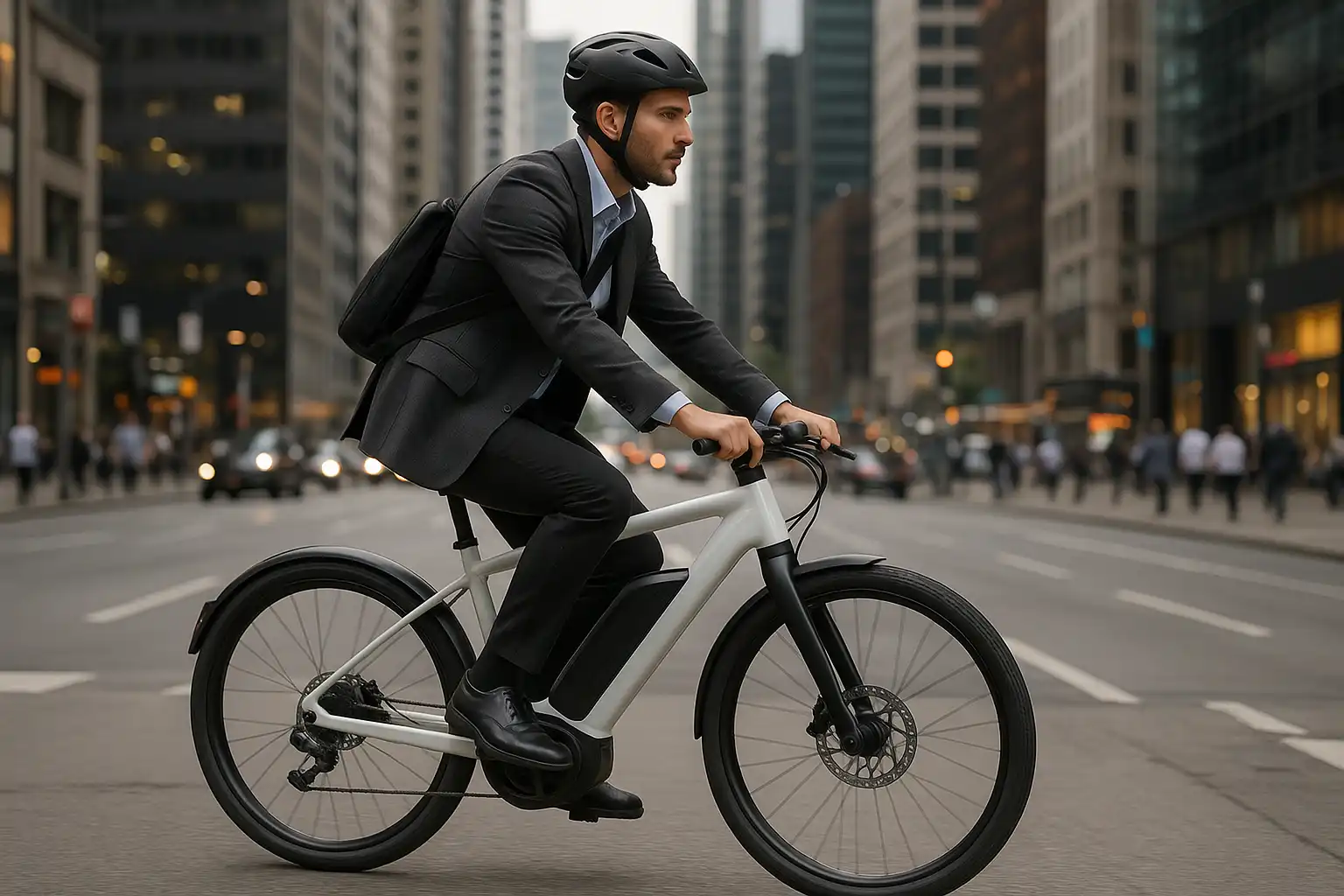The electric bike revolution is no longer coming—it’s here, and it’s transforming the cycling landscape at an unprecedented pace. In 2025, the global e-bike market is projected to exceed $90 billion, representing a staggering 47% surge in e-bike trips compared to previous years. This isn’t just growth; it’s a fundamental shift in how we think about transportation, fitness, and urban mobility.
Electric bikes have evolved from simple motorized bicycles to sophisticated machines that seamlessly blend human power with cutting-edge technology. Today’s e-bikes are smarter, more efficient, and more integrated into our digital lives than ever before. They’re not just changing how we ride—they’re changing how we live, work, and interact with our communities.
## The Smart Revolution: Connected E-Bikes
The most significant advancement in e-bike technology for 2025 is the integration of smart features that transform these machines into connected devices. Modern e-bikes are equipped with sophisticated computer systems that can communicate with smartphones, GPS networks, and even other vehicles on the road.
Smart e-bikes feature integrated displays that provide real-time information about speed, battery life, navigation, and even weather conditions. These displays are becoming increasingly sophisticated, with some models featuring full-color touchscreens that rival those found in automobiles. The integration of smartphone connectivity allows riders to access apps, receive notifications, and even control their bike’s settings remotely.
One of the most exciting developments in smart e-bike technology is the integration of artificial intelligence. AI-powered systems can learn from a rider’s habits and preferences, automatically adjusting motor assistance levels, suggesting optimal routes, and even predicting maintenance needs. This level of personalization makes e-bikes more efficient and user-friendly than ever before.
The connectivity features of modern e-bikes also extend to security. Many e-bikes now include GPS tracking systems that can help locate stolen bikes and provide real-time location data to owners. Some models even feature remote locking systems that can be controlled via smartphone apps, adding an extra layer of security for urban commuters.

## Battery Technology: The Heart of E-Bike Innovation
The rapid advancement of battery technology is perhaps the most crucial factor driving the e-bike revolution. Modern lithium-ion batteries are lighter, more powerful, and longer-lasting than their predecessors, enabling e-bikes to travel farther and perform better than ever before.
The latest generation of e-bike batteries features significantly improved energy density, allowing manufacturers to create smaller, lighter battery packs that don’t compromise on range. Many 2025 e-bikes can travel 60-100 miles on a single charge, making them practical for long commutes and recreational rides. This extended range has been a game-changer for e-bike adoption, as range anxiety was previously one of the primary barriers to e-bike ownership.
Fast-charging technology has also revolutionized the e-bike experience. Modern e-bike batteries can be charged to 80% capacity in as little as 2-3 hours, and some models feature removable batteries that can be charged indoors while the bike remains parked outside. This convenience factor has made e-bikes much more practical for daily use, particularly for commuters who need to charge their bikes at work or home.
Battery management systems have become increasingly sophisticated, featuring advanced algorithms that optimize charging cycles and extend battery life. These systems can monitor individual cell performance, balance charging across the battery pack, and even provide predictive maintenance alerts to help riders maximize their battery’s lifespan.
The integration of regenerative braking technology in some e-bikes allows the battery to be recharged while riding, particularly during downhill sections or when braking. While this technology doesn’t dramatically extend range, it does improve overall efficiency and helps riders get the most out of each charge.
## Motor Technology: Power and Efficiency Combined
E-bike motor technology has advanced dramatically, with modern motors offering more power, better efficiency, and smoother operation than previous generations. The trend toward mid-drive motors continues to dominate the high-end e-bike market, as these systems provide better weight distribution and more natural riding characteristics.
Mid-drive motors are integrated into the bike’s bottom bracket area, allowing them to leverage the bike’s existing gearing system. This integration provides several advantages, including better hill-climbing ability, more efficient power delivery, and improved handling characteristics. The latest mid-drive motors are also significantly quieter than their predecessors, providing a more pleasant riding experience.
Hub motors, while less sophisticated than mid-drive systems, continue to improve and remain popular for entry-level and commuter e-bikes. Modern hub motors are more efficient and reliable than earlier versions, and they offer the advantage of simpler installation and maintenance. Some manufacturers are developing innovative hub motor designs that incorporate multiple power levels and regenerative braking capabilities.
The integration of torque sensors in modern e-bike motors has revolutionized the riding experience. These sensors measure how hard the rider is pedaling and adjust motor assistance accordingly, creating a more natural and intuitive riding experience. This technology makes e-bikes feel more like traditional bicycles while still providing the benefits of electric assistance.
Motor control systems have also become more sophisticated, with many e-bikes featuring multiple assistance modes that can be customized to suit different riding conditions and preferences. Some systems even feature automatic mode selection that adjusts assistance levels based on terrain, speed, and rider input.
## Urban Mobility Revolution: E-Bikes in the City
The impact of e-bike technology on urban mobility cannot be overstated. Cities around the world are recognizing e-bikes as a crucial component of sustainable transportation systems, and this recognition is driving both infrastructure development and policy changes that support e-bike adoption.
E-bikes are particularly well-suited to urban environments because they can help riders cover longer distances without arriving sweaty or exhausted. This capability makes them practical alternatives to cars for commuting, errands, and recreational riding. The ability to maintain higher speeds with less effort also makes e-bikes competitive with other forms of transportation in urban settings.
The integration of e-bikes into bike-sharing systems has been one of the most significant developments in urban mobility. Cities worldwide are deploying fleets of shared e-bikes that can be accessed via smartphone apps, providing residents and visitors with convenient access to electric transportation. These systems are particularly popular because they eliminate the need for individual ownership while still providing the benefits of e-bike technology.
Traffic management systems are also beginning to incorporate e-bikes into their planning and optimization algorithms. Some cities are developing dedicated e-bike lanes and infrastructure that recognizes the unique characteristics of electric bikes, including their higher speeds and different acceleration patterns compared to traditional bicycles.
The environmental benefits of e-bike adoption in urban areas are substantial. Studies show that e-bikes produce significantly lower emissions than cars, even when accounting for electricity generation and battery manufacturing. As more people switch from cars to e-bikes for short and medium-distance trips, cities are seeing measurable improvements in air quality and reductions in traffic congestion.
## E-Bike Safety: Technology Meets Protection
As e-bikes become more popular and capable, safety technology has become increasingly important. Modern e-bikes incorporate various safety features designed to protect riders and make them more visible to other road users.
Integrated lighting systems are now standard on most e-bikes, with many models featuring automatic lights that adjust brightness based on ambient conditions. Some e-bikes include turn signals and brake lights that communicate the rider’s intentions to other road users, similar to automotive lighting systems.
Advanced braking systems have also become more common on e-bikes, with many models featuring hydraulic disc brakes that provide superior stopping power. Some e-bikes even include anti-lock braking systems (ABS) that prevent wheel lockup during emergency braking situations.
The integration of radar and proximity sensors in some high-end e-bikes provides riders with alerts about approaching vehicles or obstacles. These systems can provide audible or visual warnings to help riders stay aware of their surroundings, particularly in busy urban environments.
Helmet technology has also evolved to complement e-bike safety features. Smart helmets with integrated lights, turn signals, and communication systems are becoming more popular among e-bike riders. Some helmets even include crash detection systems that can automatically alert emergency contacts in the event of an accident.
## The Economics of E-Bike Ownership
The economics of e-bike ownership have become increasingly favorable as technology has improved and costs have decreased. While e-bikes still represent a significant initial investment, the total cost of ownership is often lower than car ownership when considering fuel, insurance, maintenance, and parking costs.
The improved reliability and durability of modern e-bike components mean that maintenance costs are generally lower than in previous years. Battery technology improvements have also extended the lifespan of e-bike batteries, reducing the frequency and cost of battery replacements.
Many governments and municipalities offer incentives for e-bike purchases, recognizing their environmental and transportation benefits. These incentives can significantly reduce the upfront cost of e-bike ownership and make electric bikes more accessible to a broader range of consumers.
The resale value of e-bikes has also improved as the market has matured and standardized. High-quality e-bikes from reputable manufacturers tend to retain their value well, making them a more attractive investment for consumers.
## E-Bikes and Health: Redefining Exercise
One of the most significant benefits of e-bike technology is its ability to make cycling accessible to people who might not otherwise be able to ride regularly. The electric assistance provided by e-bikes allows older adults, people with physical limitations, and those recovering from injuries to enjoy the benefits of cycling.
Research has shown that e-bike riders often get more exercise than traditional cyclists because they ride more frequently and for longer distances. The electric assistance removes many of the barriers that prevent people from cycling regularly, such as hills, headwinds, and physical fatigue.
The ability to adjust assistance levels on modern e-bikes allows riders to customize their workout intensity. Riders can use higher assistance levels when they want an easier ride and lower assistance levels when they want more exercise. This flexibility makes e-bikes suitable for a wide range of fitness levels and goals.
E-bikes are also proving valuable for rehabilitation and physical therapy applications. The controlled assistance provided by e-bikes allows healthcare providers to gradually increase patients’ activity levels while monitoring their progress and ensuring their safety.
## The Future of E-Bike Technology
Looking ahead, the future of e-bike technology promises even more exciting developments. Advances in battery technology, including solid-state batteries and improved energy density, will likely result in lighter, longer-range e-bikes with faster charging capabilities.
The integration of artificial intelligence and machine learning will continue to improve, with e-bikes becoming more responsive to individual rider preferences and environmental conditions. Predictive maintenance systems will become more sophisticated, helping riders avoid mechanical issues and extend the life of their bikes.
Connectivity features will continue to expand, with e-bikes becoming more integrated into smart city infrastructure and transportation networks. Vehicle-to-everything (V2X) communication technology may allow e-bikes to communicate with traffic signals, other vehicles, and infrastructure systems to improve safety and efficiency.
Sustainable manufacturing practices will become increasingly important as the e-bike industry matures. Manufacturers are already exploring ways to reduce the environmental impact of e-bike production, including the use of recycled materials and more sustainable battery technologies.
## Choosing the Right E-Bike Technology
With so many technological options available, choosing the right e-bike can be overwhelming. The key is to identify your primary use cases and prioritize features that align with your needs and preferences.
For urban commuters, features like integrated lights, fenders, racks, and theft protection may be most important. Recreational riders might prioritize range, comfort features, and off-road capabilities. Performance-oriented riders may focus on motor power, advanced display features, and connectivity options.
It’s also important to consider the long-term support and service availability for any e-bike technology. Choosing bikes from established manufacturers with good service networks can help ensure that your e-bike remains functional and up-to-date throughout its lifespan.
## Conclusion: Embracing the Electric Future
The e-bike technology revolution of 2025 represents a fundamental shift in how we think about transportation, exercise, and urban mobility. As electric bikes become smarter, more efficient, and more accessible, they’re opening up new possibilities for sustainable transportation and healthy living.
The rapid advancement of e-bike technology shows no signs of slowing down, with continued innovations in batteries, motors, connectivity, and safety features. As these technologies mature and become more affordable, e-bikes will likely become an increasingly common sight on roads and bike paths around the world.
For cyclists considering making the switch to electric, there has never been a better time to explore e-bike technology. The combination of improved performance, enhanced features, and growing infrastructure support makes 2025 an ideal year to experience the benefits of electric cycling.
Whether you’re looking to reduce your environmental impact, improve your health, or simply enjoy a more convenient and enjoyable cycling experience, modern e-bike technology offers solutions that can transform your relationship with cycling and transportation.




